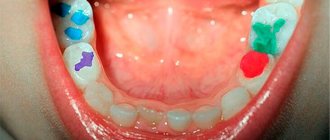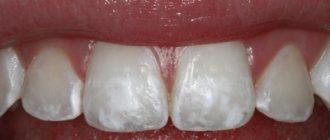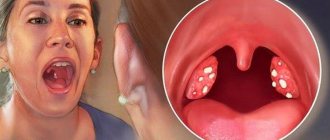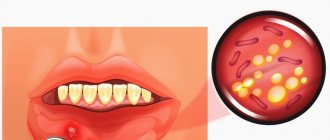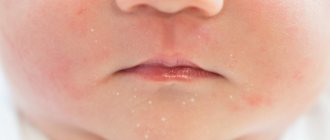A snow-white smile is the dream of many people, but there are times when white teeth are not pleasing, but saddening. This happens when white spots appear on the teeth. The appearance of chalky lesions indicates a deficiency of minerals in the surface layer of the tooth (demineralization). Tooth enamel does not regenerate like nails or hair, so losing it can have serious consequences. Gradually, the surface of the tooth loses its matte shine in the area of the stain and becomes rough. This leads to the rapid growth of bacterial colonies, which soften the enamel and provoke inflammatory diseases.
Causes of white spots on teeth
Pigment spots can be small, glossy, barely noticeable. If you ignore them, they enlarge and become dull and porous. There are several reasons for their appearance.
Carious lesions
Changes in tone first appear in the gingival area. A whitish tint can appear on one tooth or on several at once. Over time, the surface becomes thinner, the healthy shine disappears, and roughness is noticeable. The enamel becomes thin and vulnerable, the process of destruction begins, and dark spots appear on the teeth.
Hypoplasia
Underdevelopment of enamel due to congenital pathologies. During pregnancy, the mother suffered from infectious diseases, had serious toxicosis, or other disorders were recorded.
Fluorosis
Oversaturation of the body with fluoride. Characteristic of some regions with a special water composition. May be a consequence of improper intake of dietary supplements. In this case, the first marks appear on the frontal teeth and spread to the remaining units. After some time, the shade changes - now brown spots are visible on the teeth.
Long-term mechanical impacts
For example, when wearing braces and other orthopedic structures for a long time, weak enamel wears away. A white spot appears on the tooth.
Injury
Upon impact, a microcrack appears, which is difficult to see. Or the patient does not consider a scratch that does not cause inconvenience to be a serious defect. But the integrity of the enamel is damaged, bacteria destroy the tissue, and a dark stain appears on the teeth.
Insufficient hygiene
Dental plaque accumulates in the interdental spaces, in hard-to-reach areas, and the destructive process begins.
Tooth granuloma: what to do?
If, based on some signs, you suspect that you have a dental granuloma, make an appointment with your dentist as soon as possible. Treatment of granuloma should only be carried out by a specialist! We will explain in detail below why you should not self-medicate.
Why can’t dental granuloma be treated with antibiotics at home?
Antibiotics are used to treat dental granuloma - you can read about this on the Internet, on the websites of dental clinics. But under no circumstances should this information be taken as a direct guide to action. Firstly, you need to make sure that you have a dental granuloma and not some other disease, and secondly, you need to choose the right antibiotic.
In addition, just taking an antibiotic to treat dental granuloma is not enough - you need to treat the root canals of the tooth, and this cannot be done at home.
Will folk remedies help with granuloma?
Experimenting with folk remedies for dental granuloma also risks your own health. You need to remember one very simple thing: no decoction, infusion or compress will remove or cure the inflammation located in the root part of the tooth. Treatment of dental granuloma can only be carried out by a dentist, who should be contacted if you have symptoms of this disease!
The appearance of spots in children
White spots on a child’s teeth often develop due to hypoplasia or reduced immunity. A weakened body becomes vulnerable, the enamel becomes thinner, and the demineralization process starts quickly. Spots appear on the surface of the teeth - bacteria begin to destroy the tissue structure, these are manifestations of caries in the initial stage.
If a child is undergoing orthodontic treatment, then you should follow the doctor’s recommendations and not ignore in-office cleaning of the structures. Braces make it difficult to physiologically clean the surface of the teeth with saliva; the enamel dries out and its shade changes, becoming brown.
Children in their early teens are three times more likely to develop fluorosis than adults. The reason is clear - during this period there is an active change of teeth, tooth enamel is formed. Therefore, doctors focus the attention of adults: the maximum daily dose of fluoride for children is 3 mg.
Light or yellow spots on the teeth appear when the pH of saliva changes - this is a consequence of poor nutrition (for example, eating a lot of sweets).
Fragility of units and the presence of yellow spots in children and adolescents often indicate a lack of minerals. The reason is a weakened state after illness or poor nutrition. The menu for children and teenagers should include foods containing phosphorus, potassium, calcium, and other minerals. You can use high-quality dietary supplements recommended by your dentist.
Treatment methods for dental granuloma: how dental granuloma is treated in dentistry
Treatment of dental granuloma usually involves conservative therapy, during which the tooth canals are treated, their temporary filling is carried out for up to 3 weeks, and only after the image shows the cessation of the inflammatory process of the tooth - permanent filling of the canals and restoration of the tooth with a filling.
But in some cases, when a dental granuloma is diagnosed, surgical treatment is performed. Usually, surgical treatment of a tooth with granulomas is resorted to when there is obstruction of the dental canals, the impossibility of unsealing the canals, the treatment of which was carried out previously and was of poor quality, when a crown is installed on the tooth, or when there is a pin in the tooth canals.
Below we will look in detail at all methods of treating granuloma and start with conservative therapy.
Why good oral hygiene is important
You need to brush your teeth twice a day with a properly selected toothpaste and brush, and floss after each meal. Why do white spots appear on teeth even when hygiene rules are followed?
Sometimes the cause of thinning enamel is the constant use of highly abrasive toothpastes. There are patients who try to use “grandmother’s” cleaning recipes, not taking into account their traumatic nature for the enamel. In this case, the hygienic procedure will only speed up the transformation of a small spot on the tooth into a full-fledged carious area.
Using a standard toothbrush on your own cannot remove all microparticles of food or remove pathogenic microflora. Therefore, regular professional cleaning using special equipment in the clinic is necessary.
What to do if a white spot appears
Do not experiment with treatment. You should not try to remove them with soda, acids and other aggressive substances. Since the appearance of the stain is due to weakening of the enamel. This requires restoration, during which you should treat your teeth very carefully. Do not use hard brushes or whitening pastes, otherwise the light spots will quickly turn into superficial caries.
With proper care there is no need to be afraid of this. Pay special attention to your diet. Add foods rich in calcium, zinc and magnesium to your diet.
You can additionally take a course of vitamins and minerals. The ASEPTA vitamin and mineral complex, designed specifically to maintain dental health, is perfect. It will help strengthen blood vessels, increase the resistance of the oral cavity to infections, and improve the condition of dental tissues.
As for diet, eat seafood, fish, meat, fruits and green vegetables, and herbs more often. Try to reduce the amount of sweets, refined oils and other junk foods as much as possible.
How do stains appear on the enamel surface?
The surface of a healthy tooth is smooth and glossy. But it is constantly affected by many destructive factors.
Acids released by microorganisms can wash minerals out of the enamel, thus gradually becoming weaker. This happens when bacteria and their waste products (soft plaque) accumulate on the teeth. All this is a direct consequence of poor hygiene or eating too many sweets. In addition, poor immunity and poor health can also have an impact.
Also, the cause of white spots can be a lack of calcium and vitamin D. This situation leads to multiple caries. It is usually triggered by poor nutrition, poor sleep or prolonged stress. In this case, it is necessary to improve the health of the whole body. It is best to undergo a full examination and tests to know exactly what you are dealing with.
If the dots appear from an excess of fluoride, it is better to significantly reduce its intake with food, and also switch to toothpastes that do not contain this element in their composition.
Treatment
In cases where white spots are harbingers of superficial caries, remineralizing therapy will help. Today, dentists offer many options on how to reverse negative processes and strengthen teeth. The most popular of them: fluoridation, ozone, ICON, mineralization, electrophoresis. The list, of course, does not end there. Your doctor will decide which solution is best for you. He will definitely give you some tips to improve the general condition of the body. After all, weakening teeth indicate a lack of minerals. Therefore, therapy alone will not be enough. Good nutrition and sleep are very important, and perhaps take a break for a while to reduce stress.
In addition, you can help the dentist by using specialized toothpastes and taking vitamins. You can also use various folk remedies in moderation. In any case, be sure to consult your doctor about this. These methods are not a panacea. They only help speed up the recovery process.
We offer several simple recipes:
- Mix one teaspoon of vinegar and two teaspoons of baking soda to form a paste. Brush your teeth with this mixture for about two minutes, rinse your mouth thoroughly. Repeat the procedure twice a week.
- You can try using lemon juice and salt, but you need to do this with great caution. This procedure will help remove stains and reduce bad breath.
- You can also periodically rub banana peels on your teeth; they are full of magnesium, calcium and manganese. After this, be sure to brush your teeth thoroughly, as leftover banana peels can become good food for bacteria.
Prevention
It is easiest to detect on the front teeth, but if they appear in a place that is difficult for the eyes to see, everything is much more complicated. This will most likely lead to a diagnosis of dental caries. But there is an excellent option to reduce this probability to a minimum - prevention.
Dental care in this case includes dental care, home daily activities and improved nutrition.
Professional care
Even if not a single tooth hurts, do not forget to visit the dentist once or twice a year. A specialist will help identify problems in the early stages, which means their treatment will be easier and much cheaper.
In addition, WHO recommends that everyone have their teeth professionally cleaned every year. No matter how thoroughly we brush our teeth, food debris can still accumulate, forming soft and hard plaque in hard-to-reach places. A good cleaning will help you get rid of all this, and in addition, it will allow the true color of the enamel to come out, getting rid of unnatural yellowness.
Today there are several types of cleaning:
- laser – deposits are removed by heating the enamel with a beam of light;
- ultrasonic will help remove not only soft deposits, but also tartar; cleaning is carried out using a special device - a scaler - it creates high-frequency sound vibrations;
- cleaning with professional pastes and brushes with hooks to remove plaque;
- Air Flow is a procedure in which teeth are polished with an abrasive solution that is supplied under pressure.
Most often, the procedure includes several cleaning options at once. That is, the doctor first removes hard deposits with ultrasound, then polishes with Air Flow and finally coats the teeth with a special fluoridating solution. Technologies may vary. But their main goal is to clean the teeth as much as possible and protect them from harmful effects for some time.
Home care
If you want to keep your teeth healthy, use high-quality specialized toothpastes, and don’t forget about dental floss and rinses. An integrated approach will help reduce the risk of caries, as it can significantly reduce the number of bacteria in the oral cavity. Carry out the procedures at least twice a day. It is best to use dental floss or at least chewing gum after each meal.
Diet and lifestyle
Watch what you eat carefully. Avoid a lot of sweets and other unhealthy ones. Try to reduce the number of cigarettes you smoke if you have this bad habit.
Sources:
- Report on the determination/confirmation of the preventive properties of personal oral hygiene products “ASEPTA PLUS” Remineralization doctor-researcher A.A. Leontyev, head Department of Preventive Dentistry, Doctor of Medical Sciences, Professor S.B. Ulitovsky First St. Petersburg State Medical University named after. acad. I.P. Pavlova, Department of Preventive Dentistry
- The use of new anti-inflammatory drugs in the complex of therapeutic and preventive measures for periodontal diseases (E.D. Kuchumova, A.A. Leontyev, O.V. Kalinina, L.Yu. Orekhova, S.B. Ulitovsky) E.D. Kuchumova, Ph.D., Associate Professor, A.A. Leontyev, dentist, O.V. Kalinina, dentist, L.Yu. Orekhova, Doctor of Medical Sciences, Professor, Head of Department, S.B. Ulitovsky, Doctor of Medical Sciences, Prof. Department of Therapeutic Dentistry of St. Petersburg State Medical University named after. acad. I.P. Pavlova
- The role of anti-inflammatory rinse in the treatment of periodontal diseases (L.Yu. Orekhova, A.A. Leontyev, S.B. Ulitovsky) L.Yu. OREKHOVA, Doctor of Medical Sciences, Prof., Head of Department; A.A. LEONTIEV, dentist; S.B. ULITOVSKY, Doctor of Medical Sciences, Prof. Department of Therapeutic Dentistry of St. Petersburg State Medical University named after. acad. I. P. Pavlova
Diagnostics
During the first visit, the doctor will conduct an examination and, if necessary, prescribe additional studies to clarify the cause of the appearance of white or dark spots on the molars and baby teeth.
- If spots are noticed in a child, then information about the course of pregnancy is collected - hypoplasia should be excluded.
- Drying the tooth surface allows you to detect the onset of caries. After drying, the enamel on the damaged area becomes matte. The use of magnifying microscopes makes it possible to detect minor damage - cracks, scratches.
X-rays or a tomogram may be ordered.
Treatment
The process of eliminating a defect depends on the true cause of its manifestation. Therefore, there is no single recipe: the dentist proceeds from the individual characteristics of the patient and the degree of enamel damage. If the reason:
- When caries begins, a conservative approach is popular. Remineralization is necessary: saturation of the enamel with minerals using special ionizers, the use of physiotherapy (for example, exposure to ultrasound in parallel with the application of therapeutic compresses to the teeth). It is possible to apply a special preparation that closes the pores on the enamel and restores its smoothness and hardness. If the condition worsens, therapeutic treatment and installation of a modern filling are required.
- Hypoplasia. Silvering of teeth and also saturation with minerals and fluoridation are practiced. Dietary supplements containing calcium, phosphorus, and zinc are prescribed. If the application was late, then after adulthood, veneers or crowns can be used for camouflage.
- Fluorosis. Removing stains requires the use of special applications; electrophoresis is prescribed. It is necessary to drink only filtered, purified water and do not use fluoride-containing pastes. If part of the tooth is already destroyed, a filling is necessary.
- A consequence of wearing orthodontic structures (usually braces). When light spots are visible, procedures for local remineralization are applied. Toothpastes with fluoride are prescribed.
When white or already black spots on the teeth are a delayed consequence of an injury, then, depending on the nature of the damage, the doctor will prescribe conservative restoration (local remineralization, medication) or a radical intervention with reconstruction, splinting, or prosthetics will be required.
Surgical methods for treating dental granuloma
There are several surgical techniques for treating dental granulomatosis. The specific treatment technology is selected based on the characteristics of the clinical case. Below we will briefly review all the options for surgical treatment of granulomas.
Treatment of granuloma with root resection surgery
During treatment, the tip of the tooth root is excised and removed along with the pathological tumor. The operation is carried out according to the following scheme:
- 1. The dentist will peel off the gum and cut out a section of bone from the diseased tooth to gain access to the tip of the tooth root.
- 2. The root tip is removed along with the granuloma.
- 3. Synthetic bone material is placed in the area of the removed bone and the wound is sutured.
The operation lasts about an hour and if we talk about the price of this option for treating dental granuloma, then the average cost of the service in Moscow will be 6-7 thousand rubles.
Hemisection
This option for surgical treatment of dental granuloma is chosen if the diseased tooth has a large number of roots and when it is not possible to save the tooth root affected by the inflammatory process. The operation is carried out in several stages:
- 1. The dentist will remove a flap of gum in the area of the diseased tooth.
- 2. He will cut out a small piece of bone tissue, after which he will remove the affected root, as well as granulomas.
- 3. Antiseptic treatment of the surgical wound is carried out, and then synthetic bone tissue or natural osteoplasty is placed into the cleaned cavity.
- 4. The wound is sutured and stitches are placed on it.
The treatment process ends with detailed consultation of the patient on postoperative care. Note that rehabilitation after treatment of dental granuloma using hemisection is quite long - it will take 1-1.5 months.
Removal of a tooth
Tooth extraction to treat granulomas is a last resort measure, which is resorted to only if other methods have not given the desired result. Tooth extraction in the treatment of granulomas is prescribed:
- In advanced cases, if serious complications occur;
- When forming deep gum pockets;
- If there is a large vertical crack on the tooth;
- With complete destruction of the tooth crown;
- When perforations form on the root of a tooth.
After tooth extraction, the patient is prescribed a course of antibiotics and anti-inflammatory drugs, and after the wounds have healed and the inflammation has completely stopped, the extracted tooth can be restored by implantation or prosthetics.
Prevention
Preventive measures will help strengthen the surface of the teeth and prevent the appearance of black spots on the enamel. What you can do:
- Brushing your teeth regularly, the type of toothpaste and type of brush should be discussed with your doctor.
- Visit the dentist twice a year for preventive purposes.
- Create the right diet: include foods containing minerals and substances necessary to maintain dental health. These are dairy products, vegetables and fruits (a differentiated approach is necessary, since in some cases the approach to the acids they contain is selective), eggs, lean meat, fish and other products.
It is worth paying attention to additional measures to maintain immunity: do not forget about moderate physical activity, take vitamin and mineral complexes, get vaccinations in a timely manner (especially for children).
Author: Zhukov M.A.
Should I treat or remove a tooth for granuloma?
In most cases, a tooth with a granuloma can be saved - for this purpose in modern dentistry there are a lot of effective techniques, most of which we discussed above. But it is natural that treatment should be done without extreme measures - it should not be postponed until the pain in the tooth becomes unbearable, and the cheek swells from swelling.
If you want to keep your teeth intact and healthy, you must remember one very simple rule - even the slightest pain, slight discomfort that occurs in the teeth when eating or on its own is already a serious reason to see a dentist! The sooner a granuloma is diagnosed, the higher the chances of saving your tooth!



